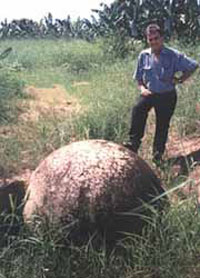|
by Ivar Zapp and George Erikson
Hundreds of books and articles have been written on the subject of Atlantis since Ignatius Donnelly came out with his seminal work, Atlantis: The Antediluvian World in 1882.
Theories on the location of Atlantis have ranged anywhere from Antarctica to outer space, and have varied in quality from well documented, well reasoned scholarly works to utter nonsense.
Fortunately, Ivar Zapp and George Erikson's
Atlantis in America rates well on the academic side of that
scale, being one of the best Atlantis books to be
found in the field of Atlantology today.
Since then, archaeology has solidified as a science, which is a good thing in that much more care is now taken when excavating sites.
However, over the last few decades archaeology has become so introverted that it has begun to lose its relevance, seemingly more interested in confirming preset notions about how things happened, instead of searching for the truth in a truly unbiased fashion, as is the heart of true science.
As a result, increasingly in the last few decades, major new discoveries have been made not by academics, but by independent archaeologists and researchers.
Such is the case with Zapp and Erikson, who have clearly done their homework on the subject. Not only have they carefully researched the history, presuppositions, and current trends in the archaeology of the Americas, but they also bring original discoveries to back up their scholarship.
Their thesis is that Atlantis was located in the Americas, specifically, around Central America. Their "Atlantis in the Americas" theory is based not only on the highly developed architecture of the Aztecs, Maya, Inca and other ancient cultures of the Americas, but also on evidence of an ancient, sophisticated maritime civilization.
In this school, Zapp theorizes, sailors were taught how to determine their location on the sea based upon the relative locations of the sun, moon and stars. The spheres, he found, were precisely machined to within a thousandth of an inch of perfect sphericity, measured up to nine feet in diameter and weighed as much as 20 tons, which is unusual in and of itself.
However, after closer examination, Zapp found that the spheres, that were typically arranged in sets of three, were so aligned as to point at various other megalithic sites around the world including the Pillars of Hercules, the Pyramids, Stonehenge, and Easter Island, among others. Some were also aligned perfectly north and south, and altogether, it became clear after some research, these stones could be used as a navigation teaching aid even today.
Zapp and Erikson decided to study the history of the area more carefully and see if these ancient Americans had any substantial knowledge of sailing. In fact, they had mastered the use of light, sturdy balsa rafts, that they could (and did) use to travel long distances.
Much of this knowledge, however, and a lot more, was suppressed or destroyed by the Catholic church after the Conquistadores conquered Central America, but enough still survives for us to learn that the native inhabitants of the area were in fact highly sophisticated astronomers, mathematicians, architects, sailors, and theologians, among other things.
Their
theological beliefs, of course, posed a threat to the Catholic
church, whose understanding of science at the time was actually
inferior to that of the Aztecs. Therefore, in their eyes,
destruction of Central American history, culture, and sciences
became an imperative.
Their case is particularly strong because, as Edgar Cayce believed, the Caribbean and Central America were actually once part of Atlantis. However, Cayce also believed that these areas were actually westernmost islands and provinces of Atlantis, and not the continent of Atlantis itself, which he, like Plato, located in the Atlantic.
Central America and the Caribbean also do not fit some of the criteria set forth by Plato, including the fact that they are not located in front of the Pillars of Hercules, they are not a large island the size of Libya and Asia, and they did not sink beneath the waves, though parts of them may have since the end of the last Ice Age.
However, that area is definitely one of the areas that the Atlanteans fled to after their islands began to sink, so the argument that these structures were Atlantean in origin is probably correct. It would be more accurate to say not that Atlantis was centered in Central America, but that Central America was part of the Atlantean culture, most likely one of its largest and most important provinces.
Plato and Cayce
both said that the main island was in the Atlantic, but that the
Atlanteans held sway over many lands to the west of that island,
which obviously points to central America and the Caribbean.
Add it to your library today, and help independent researchers like Zapp and Erikson find out the real truth about our most ancient history.
|
